None William C. Quantrill 0 300–400 Date 21 August 1863 | Civilian population of Lawrence
Unmustered recruits Quantrill's Raiders 164 civilians 40 Result Confederate victory | |
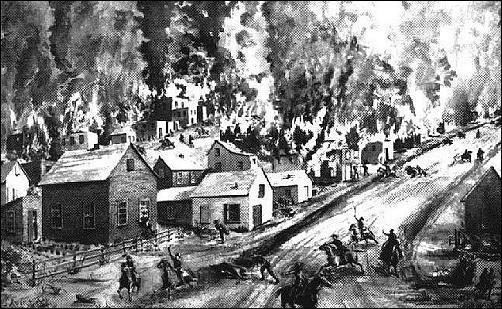 | ||
Location Lawrence, Kansas, United States Combatants Confederate States of America, Union Similar American Civil War, Sacking of Lawrence, Bleeding Kansas, Sacking of Osceola, Battle of Mine Creek | ||
The lawrence massacre story time with mr beat
The Lawrence massacre, also known as Quantrill's raid, was an attack during the American Civil War by the Quantrill's Raiders, a Confederate guerilla group led by William Quantrill, on the Union town of Lawrence, Kansas.
Contents
- The lawrence massacre story time with mr beat
- Lawrence massacre
- Background
- Motivations
- Collapse of the Womens Prison in Kansas City
- Attack
- Aftermath
- In popular media
- References
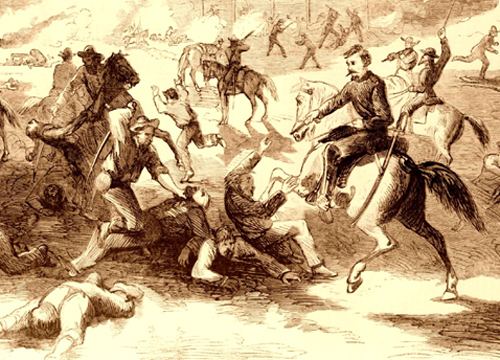
The attack on August 21, 1863 targeted Lawrence due to the town's long support of abolition and its reputation as a center for Jayhawkers and Redlegs, which were free-state militia and vigilante groups known for attacking and destroying farms and plantations in Missouri's pro-slavery western counties.
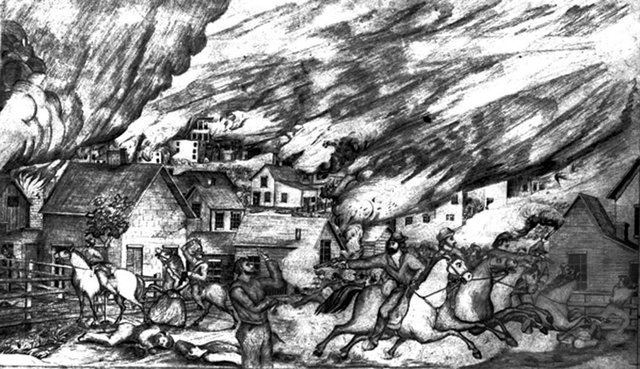
Lawrence massacre
Background
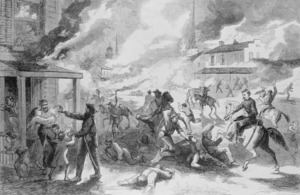
By 1863, Kansas had long been the center of strife and warfare over the admission of slave versus free states.
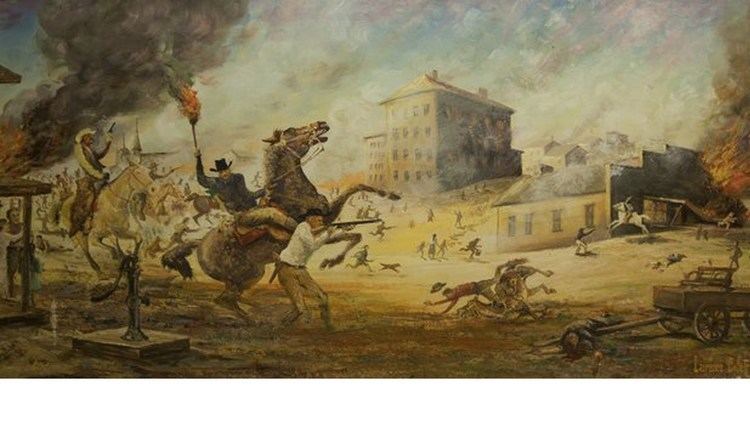
In the summer of 1856, the first sacking of Lawrence sparked a guerrilla war in Kansas that lasted for months. John Brown might be the best known participant in the violence of the late 1850s participating on the abolitionist or Jayhawker side, but numerous groups fought for each side in Bleeding Kansas.

By the beginning of the American Civil War, Lawrence was already a target for pro-slavery ire, having been seen as the anti-slavery stronghold in the state and, more importantly, a staging area for Union and Jayhawker incursions into Missouri. Initially, the town and surrounding area were extremely vigilant and reacted strongly to any rumors that enemy forces might be advancing on the town. However, by the summer of 1863, none of the threats had materialized, so citizen fears had declined and defense preparations were relaxed.
Motivations
Quantrill himself said that his motivation for the attack was "to plunder, and destroy the town in retaliation for Osceola." That was a reference to the Union's attack on Osceola, Missouri in September 1861, led by Senator James H. Lane. Osceola was plundered and nine men were given a drumhead court-martial trial and executed. Several other Missouri towns and large swaths of the Missouri countryside had been similarly plundered and burned by Unionist forces from Kansas. Castel (1999) concludes that revenge was the primary motive, followed by a desire to plunder. The retaliatory nature of the attack on Lawrence was confirmed by the survivors. "The universal testimony of all the ladies and others who talked with the butchers of the 21st ult. is that these demons claimed they were here to revenge the wrongs done their families by our men under Lane, Jennison, Anthony and Co."
Lawrence was also a headquarters for a band of Redlegs that had initiated a particularly vicious jayhawking campaign in late March 1863. The purported objective of this group was to eliminate civilian support for the Confederate guerillas, but their tactics (executions, arson, and plundering) were employed rather indiscriminately. As one observer noted (apparently a member of the Fifth Kansas Cavalry), “I believe the Red Legs will kill any man in this country for a good horse; and they have glorified themselves considerably over finishing some unarmed sympathizers.” In describing the activities of the Redlegs, Union General Blunt stated, “A reign of terror was inaugurated, and no man’s property was safe, nor was his life worth much if he opposed them in their schemes of plunder and robbery.” It is difficult to quantify the number of civilians killed by the Redlegs, but a letter written from the Lexington area early in the Redlegs campaign (April 1863) stated that the Redlegs had “killed at least fifty men, who were unarmed and heretofore lived in peace and quiet".
Charles Robinson, first Governor of Kansas and eyewitness to the raid, characterized the raid as an act of vengeance. "Before this raid the entire border counties of Missouri had experienced more terrible outrages than ever the Quantrill raid at Lawrence...There was no burning of feet and torture by hanging in Lawrence as there was in Missouri, neither were women and children outraged." Robinson explained that Quantrill targeted Lawrence because "professedly free state men" commenced their reign of terror "as soon as war broke out" and Lawrence was "headquarters for the thieves and their plunder."
Collapse of the Women's Prison in Kansas City
In a bid to put down the Missouri guerrilla raiders operating in Kansas, General Thomas Ewing, Jr. issued in April 1863 "General Order No. 10," which ordered the arrest of anyone giving aid or comfort to Confederate guerrillas. This meant chiefly women or girls who were relatives of the guerrillas. Ewing confined those arrested in a series of makeshift prisons in Kansas City. The women were sequentially housed in two buildings which were considered either too small or too unsanitary, before being moved to an empty property at 1425 Grand. This structure was part of the estate of the deceased Robert S. Thomas, George Caleb Bingham's father-in-law. In 1861 Bingham and his family were living in the structure, but in early 1862 after being appointed treasurer of the state of Missouri, he and his family relocated to Jefferson City. Bingham had added a third story to the existing structure to use as a studio.
At least ten women or girls, all under the age of 20, were incarcerated in the building when it collapsed August 13, 1863, killing four: Charity McCorkle Kerr, Susan Crawford Vandever, Armenia Crawford Selvey, and Josephine Anderson—the 15-year-old sister of William T. "Bloody Bill" Anderson. A few days later, Nannie Harris died from her wounds. Survivors of the collapse included: Jenny Anderson (crippled by the accident), Susan Anne Mundy Womacks, Martha "Mattie" Mundy, Lucinda "Lou" Mundy Gray, Elizabeth Harris (later married to Deal), and Mollie Grindstaff. Anderson's 13-year-old sister, who was shackled to a ball-and-chain inside the jail, suffered multiple injuries including two broken legs. Rumors circulated (later promulgated by Bingham who held a personal grudge against Ewing and who would seek financial compensation for the loss of the building) that the structure was undermined by the guards to cause its collapse. However, a 1995 study of the events and affidavits surrounding the collapse concludes this is "the least plausible of the theories." Instead, testimony indicated that alterations to the first floor of the adjoining Cockrell structure for use as a barracks caused the common wall to buckle. The weight of the third story on the former Bingham residence contributed to the resultant collapse.
Even before the collapse of the jail, the arrest and planned deportation of the girls had enraged Quantrill's guerillas; George Todd left a note for General Ewing threatening to burn Kansas City unless the girls were freed. While Quantrill's raid on Lawrence was planned prior to the collapse of the jail, the deaths of the guerrillas' female relatives undoubtedly added to their thirst for revenge and blood lust during the raid.
Attack
The attack was the product of careful planning. Quantrill had been able to gain the confidence of many of the leaders of independent Bushwhacker groups, and chose the day and time of the attack well in advance. The different groups of Missouri riders approached Lawrence from the east in several independent columns, and converged with well-timed precision in the final miles before Lawrence during the pre-dawn hours of the chosen day. Many of the men had been riding for over 24 hours to make the rendezvous and had lashed themselves to their saddles to keep riding if they fell asleep. Almost all were armed with multiple six-shot revolvers.
Between three and four hundred riders arrived on the outskirts of Lawrence shortly after 5 AM. A small squad was dispatched to the summit of Mount Oread to serve as lookouts, and the remainder rode into town. Their initial focus was the Eldridge Hotel, a large brick structure located on the highest point in Lawrence. After gaining control of the hotel, which then served as Quantrill's headquarters during the raid, Quantrill's force broke into smaller groups that fanned out throughout the town. Over a four-hour period, the raiders pillaged and set fire to the town and killed much of its adult male population. Quantrill's men burned to the ground a quarter of the buildings in Lawrence, including all but two businesses. They looted most of the banks and stores and killed between 185 and 200 men and boys. According to an 1897 account, among the dead were 18 of 23 unmustered army recruits. By 9 a.m., the raiders were on their way out of town, evading the few units that came in pursuit, and eventually splitting up so as to avoid Union pursuit of a unified column into Missouri.
The raid was less a battle than a mass execution. Two weeks prior to the raid, a Lawrence newspaper boasted, "Lawrence has ready for any emergency over five hundred fighting men...every one of who would like to see [Quantrill's raiders]". However, a squad of soldiers temporarily stationed in Lawrence had returned to Fort Leavenworth, and due to the surprise, swiftness, and fury of the initial assault, the local militia was unable to assemble and mount a defense. Most of the victims of the raid were unarmed when gunned down.
With revenge a principal motive, Quantrill’s raiders entered Lawrence with lists of men to be killed and buildings to be burned. Senator James H. Lane was at the top of the list. Lane was a military leader and chief political proponent of the jayhawking raids that had cut a swath of death, plundering, and arson through western Missouri (including the destruction of Osceola) in the early months of the Civil War. Lane escaped death by racing through a cornfield in his nightshirt. John Speer had been put into the newspaper business by Lane, was one of Lane’s chief political backers, and was also on the list. Speer likewise escaped execution, but two of his sons were killed in the raid. (One of Speer's sons may have been the same John L. Speer that appeared on a list of Redlegs previously issued by the Union military.) Speer’s youngest son, fifteen-year-old Billy, may have been included on the death lists, but he was released by Quantrill’s men after giving them a false name. The Speer boy later shot one of the raiders during their exit from Lawrence, causing one of the few casualties among Quantrill’s command while in Lawrence. Charles L. Robinson, first governor of Kansas and a prominent abolitionist, may also have been on the list, though he maintained he was spared because Quantrill respected his efforts to keep peace on the border at the start of the war.
While many of the victims of the raid had been specifically targeted beforehand, executions were more indiscriminate among segments of the raiders, particularly Todd's band that operated in the western part of Lawrence. The men and boys riding with "Bloody Bill" Anderson also accounted for a disproportionate number of the Lawrence dead. The raid devolved into extreme brutality. The survivors reported that one man was shot while in the arms of his pleading wife, that another was killed with a toddler in his arms, that a group of men who had surrendered under assurances of safety were then gunned down, and that a pair of men were bound and forced into a burning building where they died in horrible agony. Another dramatic story was told in a letter written on September 7, 1863 by H.M. Simpson, whose entire family narrowly escaped death by hiding in a nearby cornfield as the massacre raged all around them: "My father was very slow to get into the cornfield. He was so indignant at the ruffians that he was unwilling to retreat before them. My little children were in the field three hours. They seemed to know that if they cried the noise would betray their parents whereabouts, & so they kept as still as mice. The baby was very hungry & I gave her an ear of raw green corn which she ate ravenously."
The youth of some of the victims is often characterized as a particularly reprehensible aspect of the raid. Bobbie Martin is generally cited as being the youngest victim; some histories of the raid state he was twelve years old, while others state he was fourteen. Most accounts state he was wearing a Union soldier uniform or clothing made from his father’s uniform; some state he was carrying a musket and cartridges. (For perspective on the age of participants in the conflict, it has been estimated that about 800,000 Union soldiers were seventeen years of age or younger, with about 100,000 of those being fifteen or younger.) Most of Quantrill’s guerrilla fighters were teenagers. One of the youngest was Riley Crawford, who was thirteen when brought by his mother to Quantrill after her husband was shot and her home burned by Union soldiers.
Aftermath
The Lawrence Massacre was one of the bloodiest events in the history of Kansas. The Plymouth Congregational Church in Lawrence survived the attack, but a number of its members were killed and records destroyed.
A day after the attack, the surviving citizens of Lawrence lynched a member of Quantrill's Raiders caught in the town. On August 25, General Ewing authorized General Order No. 11 (not to be confused with Grant's famous General Order of the same name) evicting thousands of Missourians in four counties from their homes near the Kansas border. Virtually everything in these counties was then systematically burned to the ground. The action was carried out by the infamous Jayhawker, Charles "Doc" Jennison. Jennison's raids into Missouri were thorough and indiscriminate, and left five counties in western Missouri wasted, save for the standing brick chimneys of the two-storey period houses, which are still called "Jennison Monuments" in those parts.
A Missouri abolitionist and preacher described the role of the Lawrence Massacre in the region's descent into the horror of total war on the civilian population of Kansas and Missouri:
Viewed in any light, the Lawrence Raid will continue to be held, as the most infamous event of the uncivil war! The work of destruction did not stop in Kansas. The cowardly criminality of this spiteful reciprocity lay in the fact that each party knew, but did not care, that the consequences of their violent acts would fall most heavily upon their own helpless friends. Jenison in 1861 rushed into Missouri when there was no one to resist, and robbed and killed and sneaked away with his spoils and left the union people of Missouri to bear the vengeance of his crimes. Quantrell in 1863 rushed into Lawrence, Kansas, when there was no danger, and killed and robbed and sneaked off with his spoils, leaving helpless women and children of his own side to bear the dreadful vengeance invoked by that raid. So the Lawrence raid was followed by swift and cruel retribution, falling, as usual in this border warfare, upon the innocent and helpless, rather than the guilty ones. Quantrell left Kansas with the loss of one man. The Kansas troops followed him, at a respectful distance, and visited dire vengeance on all western Missouri. Unarmed old men and boys were accused and shot down, and homes with their now meagre comforts were burned, and helpless women and children turned out with no provision for the approaching winter. The number of those killed was never reported, as they were scattered all over western Missouri.
The city seal of Lawrence commemorates Quantrill's attack with its depiction of a Phoenix rising from the ashes of the burnt city.
For his part, Quantrill led his men south to Texas for the winter. By the next year, the raiders had disintegrated as a unified force, so were unable to achieve similar successes. William Clarke Quantrill died of wounds received in Kentucky in 1865, with only a few staunch supporters left. Among these appear to have been Frank James and his younger brother, Jesse James.
